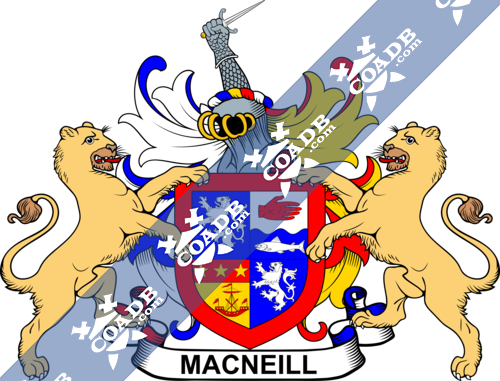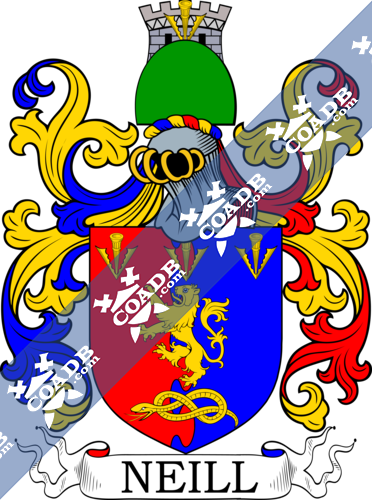MacNeill Family Crest, Coat of Arms and Name History

MacNeill Coat of Arms Gallery
Don’t know which Coat of Arms is yours?
We can do a genealogical research. Find out the exact history of your family!
Learn MoreMacNeill Origin:
England, Scotland, Ireland
Origins of MacNeill:
According to the early recordings of the spelling of the surname, this interesting and unique name was listed in many spelling forms such as MacNeill, McNeill, O’Neill, Neill, Neil, Neale, and many others, this is a surname of pre 8th-century Gaelic sources. It acquires from the word ‘niall’ which means ‘champion,’ a meaning which is greatly supported by its reputation throughout Northern Europe. It can be Irish, Scottish or Norman-English. Originally, the name was chosen in Ireland by invading Scandinavians who made Dublin their capital. Then in the form of “Njall,” it was brought both to Norway, Iceland and the Island of Man as well as into what became famous as Normandy (in France) in the 9th century. Two centuries later, these old ‘Vikings’ now Normans, crossed the English Lake and defeated England introducing the name into southern areas after 1066. However, it also was brought directly into North West England by Norsemen from Ireland, who were defeated in the region. ‘Neil’ as a first name was frequently Latinized in England as “Nigel(lus),” through an incorrect connection to “niger,” which means black.
Variations:
More common variations are: Macneille, Macneilly, McNeill, MacNeil, Macnell, Macnill, Macneillie, McNeilly, McNeille, Mackell.
Scotland:
The surname MacNeill first found in on the islands of Barra, Gigha, Colonsay, and Oronsay. According to local registers in 1049, Niall, a direct ancestor of King Niall of the Nine Hostages, landed in Barra and founded the tribe MacNeill of Barra. However, another kinsrnan, some consider being the younger brother of Niall named Anrothan, married a Princess of the Dalriadans, an old race from which rebound most of the old Scottish Kings. Legend has it that Anrothan started the MacNeill house of Colonsay through his son Torquil of Taynish. This next section gained the estates of Gigha, Colonsay, and Oronsay, before the Firth of Lorne.
England:
The very first recording spelling of the family was shown to be that of Willelmus Nigelli, dated about 1195, in the tax registers known as the “Feet of Fines” for the county of Wiltshire.” It was during the time of King Richard I, who was known to be the “The Lionheart,” dated 1189-1199. Unfortunately, Richard may have been “lionhearted” in battle, but he was usually broke as well. His expeditions to free the Holy Land and known as the Crusades, being a terrible drain on England. The origin of surnames during this period became a necessity with the introduction of personal taxation. It came to be known as Poll Tax in England.
Ireland:
Many of the people with surname MacNeill had moved to Ireland during the 17th century.
United States of America:
Some of the people with the surname MacNeill who arrived in the United States in the 19th century included Neal MacNeill, who landed in New York, NY in 1811.
Here is the population distribution of the last name MacNeill: Canada 2,384; United States 2,085; Scotland 551; England 441; Australia 184; South Africa 110; Ireland 98; New Zealand 33; Belgium 22; Zimbabwe 13.
Notable People:
Richard (“Dick”) MacNeill (January 1898 in Pasuruan, Dutch East Indies –June 1963 in Heemstede) was a football (soccer) goalkeeper from the Netherlands, who played for his home country at the 1920 Summer Olympics. There he got the bronze medal with the Netherlands national football team.
Eoin MacNeill (Irish: Eoin Mac Néill; May 1867–October 1945) was an Irish researcher, Irish language supporter, nationalist activist, and Sinn Féin leader.
Hector Macneill (October 1746–March 1818) was a Scottish poet born near Roslin, Midlothian, Scotland.
Torquil MacNeill (Scottish Gaelic: Torcall MacNèill) was a mid-sixteenth century tribe Head. In the sixteenth century, there was a tribe of MacNeills centered on the Inner Hebridean Isle of Gigha.
Peter MacNeill is a Canadian film and television artist who has performed in many TV shows and films.
Blazons & Genealogy Notes
1) (Barra, co. Inverness; chief of the MacNeils, an ancient clan of the Western Isles, in ancient times enrolled under the standards of the Lords of the Isles; now representedby Colonel Roderick MacNeill, of Barra). Motto—Vincere vel mori. Quarterly, 1st, vert a lion ramp. or; 2nd, ar. in base the sea with a castle above the sea ppr.; 3rd, or, a lymphad sa. sails furled; 4th, or, a dexter hand erect, couped gu. within an orle of nine fetterlocks gu. Crest—A rock ppr. Supporters—Two lions ramp. ppr.
2) (or McNeill). (Barra, co. Inverness; chief of the MacNeils, an ancient clan of the Western Isles, in ancient times enrolled under the standards of the Lords of the Isles; now representedby Colonel Roderick MacNeill, of Barra). Motto—Vincere vel mori. Quarterly, 1st, vert a lion ramp. or; 2nd, ar. in base the sea with a castle above the sea ppr.; 3rd, or, a lymphad sa. sails furled; 4th, or, a dexter hand erect, couped gu. within an orle of nine fetterlocks gu. Crest—A rock ppr. Supporters—Two lions ramp. ppr.
3) (or McNeill). (Gigha, co. Argyll). Motto—Vincere vel mori. Quarterly, 1st and 4th, az. a lion ramp. ar.; 2nd, ar. a sinister hand couped fesseways in chief gu. and in base wavy az. a salmon naiant of the first; 3rd, or, a galley, her oars in saltire gu. on a chief of the last three mullets of the first. Crest—An armed man, from the shoulder issuing, holding a dagger point upwards all ppr.
4) (or McNeill). (Baron Colnnsay). Motto—Vincere aut mori. As the last, within a bordure erm. Crest—A mailed arm and hand holding a dagger ppr. Supporters—Two Highland deerhounds ppr.
5) (or McNeill). (Sir John M’Neil, G.C.B., 1857). As Gigha, within a bordure gu. Crest and Motto, as Lord Colonsay. Supporters—Two Persian lions without manes ppr.
6) (or McNeill). (Reg. Ulster’s Office to Sir John Macneill, Knt., Professor of Practical Engineering, Trinity College, Dublin, on whom the Earl de Grey conferred the honour of knighthood at the opening of the Dublin and Drogheda Railway, 1844). Motto—Vincere vel mori. (confirmed by Betham, Ulster, to Sir John Mac Neill, Knt., D.C.L., F.R.S., son of Torquil Parkes Mac Neill, Esq., of Mount Pleasant, co. Louth, and grandson of John Mac Neill, of Lower Fanchard, co. Louth, descended from a Highland family of Mac Neill, of Gaya and Fearfergus, co. Argyll). Motto—Vincere aut mori. Per fess in chief per pale az. and ar. the base or, in dexter chief a lion ramp, of the second, in sinister chief a dexter hand couped at the wrist, lying fessway, and a salmon naiant in waves of the sea all ppr. in base a lymphad gu. oars in action of the last, on a chief also of the last three mullets of the third. Crest—An arm in armour embowed, the hand holding a sword all ppr.
7) (or McNeill). (Reg. Ulster’s Office). Motto—Per virtutem scientamque. Quarterly, 1st, az. a lion ramp, ar.; 2nd, or, a dexter arm couped below the elbow lying fessways gu. the hand grasping a cross crosslet fitchee az.; 3rd, or, a lymphad sa.; 4th, ar. out of waves of the sea in base ppr. a rock issuant gu. Crest—A rock gu.
8) (England). Or, a galley, sails furled and oars in action sa. in chief a dexter hand couped fesseways gu. holding a dagger point downwards az. betw. two crosses crosslet fitchée of the third. Crest—A unicorn’s head erased gu.
9) Purp. three griffins’ heads ar.
10) (Andrew Charles Brisbane Neill, Esq., 22, Ryder Street, St. James’s. Westminster). Motto—Floreseo favente Deo. Per pale nebulee gu. and az. a lion ramp. betw. three pheons in chief and a serpent nowed in base all or. Crest—Upon a mount vert the embattlements of a tower ppr. surmounted by a pheon or.
















